Hooke - Study guides, Class notes & Summaries
Looking for the best study guides, study notes and summaries about Hooke? On this page you'll find 1046 study documents about Hooke.
Page 4 out of 1.046 results
Sort by
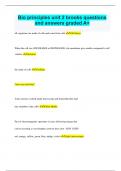
-
Bio principles unit 2 brooks questions and answers graded A+
- Exam (elaborations) • 36 pages • 2024
-
- $10.49
- + learn more
all organisms are made of cells and come from cells Cell theory When the cell size (INCREASES or DECREASES), the membrane gets smaller compared to cell volume. increases the study of cells Cytology "how can cork float" Took sections, looked under microscope and found that they had tiny chambers (aka cells) Robert Hooke Part of electromagnetic spectrum via sun, delivering energy that can be recorded as wavelengths (convert into color - ROY G BIV: red, orange, yellow, green, blue, indig...
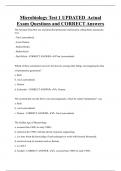
-
Microbiology Test 1 UPDATED Actual Exam Questions and CORRECT Answers
- Exam (elaborations) • 29 pages • 2024
-
- $10.49
- + learn more
Microbiology Test 1 UPDATED Actual Exam Questions and CORRECT Answers The Scientist That first saw and described protozoans and bacteria calling them animacules was: - Van Leeuwenhoek - Louis Pasteur - Robert Hooke - Robert Koch - Paul Erlich - CORRECT ANSWER- Van Leeuwenhoek
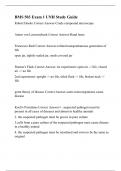
-
BMS 503 Exam 1 UNH Study Guide
- Exam (elaborations) • 15 pages • 2024
-
- $13.49
- + learn more
Robert Hooke Correct Answer-Crude compound microscope Anton von Leeuwenhoek Correct Answer-Hand lense Francesco Redi Correct Answer-refuted nonspontaneous generation of life open jar, tightly sealed jar, mesh covered jar Pasteur's Flask Correct Answer-1st experiment: open air -> life, closed air -> no life 2nd experiment: upright -> no life, titled flask -> life, broken neck -> life germ theory of disease Correct Answer-some microorganisms cause disease Koch's P...
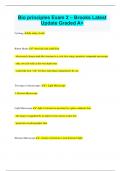
-
Bio principles Exam 2 – Brooks Latest Update Graded A+
- Exam (elaborations) • 63 pages • 2024
-
- $12.99
- + learn more
Cytology the study of cells Robert Hooke - observed cork could float - discovered a honeycomb-like structure in a cork slice using a primitive compound microscope - only saw cell walls as this was dead tissue - coined the term "cell" for these individual compartments he saw Two types of microscopes: 1. Light Microscope 2. Electron Microscope Light Microscope - light is focused on specimen by a glass condenser lens - the image is magnified by an objective lens and an ocular lens - proj...
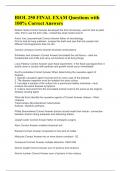
-
BIOL 250 FINAL EXAM Questions with 100% Correct Answers
- Exam (elaborations) • 10 pages • 2024
- Available in package deal
-
- $12.99
- + learn more
Robert Hooke Correct Answer developed the first microscope, used to look at plant cells, first to use the term cells-- looked like what monks lived in Anton Van Leeuwenhoek Correct Answer father of microbiology First to look at living material-- scraped his teeth and saw that sick people had different microogranisms than his did Carolus Linnaeus Correct Answer binomial nomenclature Schleiden and schwann Correct Answer formulated the cell theory-- cells are fundamental unit of life and ...
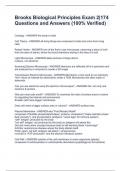
-
Brooks Biological Principles Exam 2|174 Questions and Answers (100% Verified)
- Exam (elaborations) • 17 pages • 2024
- Available in package deal
-
- $11.99
- + learn more
Brooks Biological Principles Exam 2|174 Questions and Answers (100% Verified)Brooks Biological Principles Exam 2|174 Questions and Answers (100% Verified)Brooks Biological Principles Exam 2|174 Questions and Answers (100% Verified) Cytology - ANSWER-the study of cells Cell Theory - ANSWER-all living things are composed of cells and come from living cells Robert Hooke - ANSWER-one of the first to use microscope, observing a piece of cork from the stem of plants, where he found chambers ari...
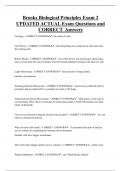
-
Brooks Biological Principles Exam 2 UPDATED ACTUAL Exam Questions and CORRECT Answers
- Exam (elaborations) • 24 pages • 2024
- Available in package deal
-
- $9.99
- + learn more
Brooks Biological Principles Exam 2 UPDATED ACTUAL Exam Questions and CORRECT Answers Cytology - CORRECT ANSWER- the study of cells Cell Theory - CORRECT ANSWER- all living things are composed of cells and come from living cells Robert Hooke - CORRECT ANSWER- one of the first to use microscope, observing a piece of cork from the stem of plants, where he found chambers arising in the idea of a cell.
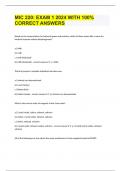
-
MIC 220: EXAM 1 2024 WITH 100% CORRECT ANSWERS
- Exam (elaborations) • 22 pages • 2024
-
- $17.49
- + learn more
Based on the nomenclature for bacterial genes and proteins, which of these seems like a name for bacterial enzyme malate dehydrogenase? a.) Mdh b.) mdh c.) mdh (italicized) d.) Mdh (italicized) - correct answer a.) Mdh The first person to visualize individual microbes was a.) Antonie van leeuwenhoek b.) Louis Pasteur c.) Robert Koch d.) Robert Hooke - correct answer a.) Antonie van leeuwenhoek What is the correct order of reagents in the Gram stain? a.) Crystal violet, iodin...
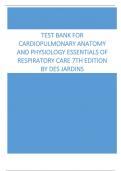
-
Test Bank for Cardiopulmonary Anatomy and Physiology Essentials of Respiratory Care 7th Edition by Des Jardins
- Exam (elaborations) • 339 pages • 2023
-
- $20.49
- 18x sold
- + learn more
Test Bank for Cardiopulmonary Anatomy and Physiology Essentials of Respiratory Care 7th Edition by Des Jardins Chapter 2 Ventilation MULTIPLE CHOICE 1. What instrument is used to measure P atm ? a. dynameter c. barometer b. altimeter d. hygrometer ANS: C Feedback A B C D A barometer is used to measure barometric (P B A barometer is used to measure barometric (P B A barometer is used to measure barometric (P B A barometer is used to measure barometric (P B ) or atmospheric (...
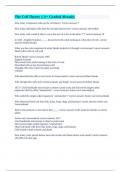
-
The Cell Theory || A+ Graded Already.
- Exam (elaborations) • 6 pages • 2024
-
- $10.69
- + learn more
How many component make up the cell theory? correct answers 7 How many individual cells does the average human have? correct answers 100 trillion How many cells would it take to cover the area of a dot on the letter "i"? correct answers 50 In 1665 - English Scientist, ____, discovered cells while looking at a thin slice of cork. correct answers Robert Hooke What was the cork comprised of when Hooke looked at it through a microscope? correct answers Dead xylem cells of cell wall ...

That summary you just bought made someone very happy. Also get paid weekly? Sell your study resources on Stuvia! Discover all about earning on Stuvia


